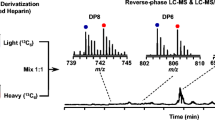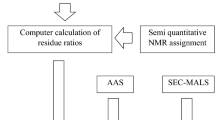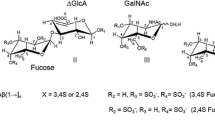Abstract
The recently revised European Pharmacopeia and US Pharmacopeia heparin sodium monographs include nuclear magnetic resonance (NMR) tests on both identity and purity. In KMnO4-bleached heparin, an unidentified NMR signal is present at 2.10 ppm at a level of 15–20% of the mean of signal height of the major glucosamine (GlcNAc/GlcNS,6S) anomeric proton signal at 5.42 ppm and of the major iduronic acid (IdoA2S) anomeric proton signal at 5.21 ppm. According to the new monographs, no unidentified signals greater than 4% should be detected at that position. Thus, the material did not meet the acceptance criterion. The signal at 2.10 ppm has been present at the same level in all released MSD KMnO4-bleached heparin sodium batches analyzed over the past 10 years. The signal is a result of the KMnO4 bleaching. No (oversulfated) chondroitin sulfate or dermatan sulfate was detected in this material. A comprehensive NMR study using long-range heteronuclear 2D techniques identifies this signal at 2.10 ppm as originating from the acetyl methyl group of (6-sulfated) 2-N-acetyl-2-deoxy-glucono-1,5-lactone. This modified monosaccharide is formed by the KMnO4 oxidation of the reducing end of a terminal N-acetylglucosamine.









Similar content being viewed by others
References
USP (2010) US Pharmacopoeia, Rockville, http://www.usp.org/hottopics/heparin.html. Accessed 24 June 2010
Guerrini M et al (2008) Oversulfated chondroitin sulfate is a contaminant in heparin associated with adverse clinical events. Nat Biotechnol 26(6):669–675
Kishimoto TK et al (2008) Contaminated heparin associated with adverse clinical events and activation of the contact system. N Engl J Med 358(23):2457–2467
US Pharmacopoeia (2009) United States Pharmacopoeia heparin sodium stage 2 monograph. US Pharmacopoeia, Rockville. http://www.usp.org/pdf/EN/hottopics/heparinSodiumMonograph.pdf. Accessed on 24 July 2010
European Pharmacopoeia (2010) European Pharmacopoeia heparin sodium monograph PA/PH/Exp. 6/T(0) 42 PUB monograph number 333 (2010). EDQM, Strasbourg, http://www.edqm.eu/medias/fichiers/NEW_Heparin_sodium_0820100333.pdf. Accessed 24 July 2010
Jeener J, Meier BH, Bachmann P, Ernst RR (1979) Investigation of exchange processes by two-dimensional NMR spectroscopy. J Chem Phys 71:4546–4553
Zwahlen C, Legault P, Vincent SJF, Greenblatt J, Konrat R, Kay LE (1997) Methods for measurement of intermolecular NOE’s by multinuclear NMR spectroscopy: application to a bacteriophage λ N-peptide/box B RNA complex. J Am Chem Soc 119:6711–6721
Wagner R, Berger S (1996) Gradient-selected NOESY—a fourfold reduction of the measurement time for the NOESY experiment. J Magn Reson 123A:119–121
Willker W, Leibfritz D, Kerssebaum R, Bermel W (1993) Gradient selection in inverse heteronuclear correlation spectroscopy. Magn Reson Chem 31:287–292
Boyer RD, Johnson R, Krishnamurthy K (2003) Compensation of refocusing inefficiency with synchronized inversion sweep (CRISIS) in multiplicity-edited HSQC. J Magn Reson 165:253–259
March J (1992) Advanced organic chemistry, 4th edn. Wiley, New York, p 781
Stryer L (1988) Biochemistry, 3rd edn. Freeman, New York, pp 334–335
Viskov C (2009) Presentation at the 3rd Workshop on the Characterization of Heparin Products, Washington DC, July 27–28, http://www.usp.org/pdf/EN/meetings/workshops/heparin2009Viskov2.pdf
Capila I (2010) Presentation at the 4th Workshop on the Characterization of Heparin Products, London, July 8–9, 2010, http://www.hpa-events.org.uk/HPA/media/uploaded/EVHPA/event_111/10.40-Dr%20Ishan%20Capila%20presentation.pdf
Viskov C (2010) Presentation at the 4th Workshop on the Characterization of Heparin Products, London, July 8–9, 2010, http://www.hpa-events.org.uk/HPA/media/uploaded/EVHPA/event_111/14.10-Dr%20Christian%20Viskov%20presentation.pdf
Becatti D, Roy S, Yu F, Sibel NS, Capila I, Lech M, Linhardt RJ, Venkatamaran G (2010) Identification of a novel structure in heparin generated by potassium permanganate oxidation. Carbohydr Polym 82(3):699–705
Mourier PAJ, Guichard OY, Frédéric H, Viskov C (2010) Heparin sodium compliance to the new proposed USP monograph: elucidation of a minor structural modification responsible for a process dependent 2.10ppm NMR signal. J. Pharm. Biomed. Anal. in press. doi:10.1016/j.jpba.2010.09.011
Author information
Authors and Affiliations
Corresponding author
Additional information
Published in the special issue Heparin Characterization with Guest Editor Cynthia K. Larive
Electronic supplementary material
Below is the link to the electronic supplementary material.
Fig. S1
1H NMR spectra (according to USP monograph) of MSD KMnO4-bleached heparin sodium batches that were released over the past 10 years. In all analyzed batches, a signal at 2.10 ppm was observed with an intensity of about 15–20% of the mean signal height of signals 1 and 2 (DOC 506 KB)
Rights and permissions
About this article
Cite this article
Kellenbach, E., Sanders, K., Michiels, P.J.A. et al. 1H NMR signal at 2.10 ppm in the spectrum of KMnO4-bleached heparin sodium: identification of the chemical origin using an NMR-only approach. Anal Bioanal Chem 399, 621–628 (2011). https://doi.org/10.1007/s00216-010-4177-7
Received:
Revised:
Accepted:
Published:
Issue Date:
DOI: https://doi.org/10.1007/s00216-010-4177-7




